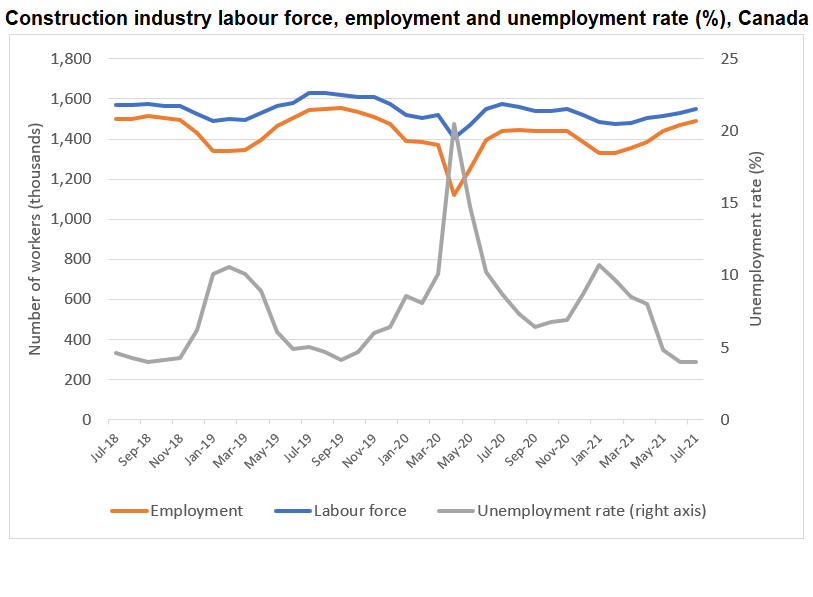Six consecutive months of growth have brought construction industry employment tantalizingly close to pre-pandemic levels.
Data from Statistics Canada’s latest Labour Force Survey (LFS) show the industry added 21,500 workers (+1.5%) in July. Construction employment is now 3.5%, or 49,900 workers, ahead of the same period in July 2020, but remains 63,600 workers below pre-pandemic levels recorded in July 2019.

Statistics Canada released its July LFS data on August 6. The survey was conducted during the week of July 11 to 17 at a time when provinces had eased, or were in the process of easing, public health restrictions due to the COVID-19 pandemic. As a result, all industry seasonally adjusted employment rose by 94,000 (+0.5%) in July. The change brought employment to 246,000 (-1.3%) workers below February 2020 levels. Growth was concentrated almost entirely in Ontario, while Manitoba, Nova Scotia, and Prince Edward Island also reported employment gains. All of the gains occurred in the private sector.
Provinces report mixed progress on key construction metrics
Across the provinces, construction employment growth was modest – a fact likely due to the industry’s role as an essential service during the pandemic. Saskatchewan reported the largest monthly gain at 6%, followed closely by Nova Scotia at 5.5%. Employment gains were seen across most other provinces, apart from Prince Edward Island (-1.6%), and in Ontario (-0.2%) and Quebec (+0.2%) where employment was virtually unchanged.
Nearly every province reported gains in industry employment compared with July 2020, with Nova Scotia (+14.3%), Quebec (+10.2%), and Newfoundland and Labrador (+10.1%) reporting the most notable gains. The remaining provinces reported gains of less than 10%. Prince Edward Island, New Brunswick, and British Columbia saw year-over-year employment declines, falling 22.1%, 5.4%, and 2.7% respectively.
Nova Scotia and Quebec are the only provinces reporting employment above pre-COVID levels.
Meanwhile, construction’s monthly unemployment rate was unchanged in July, remaining at 4%. The rate remains 4.7 percentage points below July 2020 levels and, tellingly, one point below 2019 levels.
Construction’s unemployment rate dropped or remained virtually unchanged in most provinces in July. Newfoundland and Labrador and Manitoba saw the most notable declines, falling 2.1 percentage points from June. British Columbia and Nova Scotia also reported declines of 1.9% and 1.2% respectively.
The unemployment rate rose in Prince Edward Island (+3.0%), Ontario (+1.4%), and New Brunswick (0.3%) compared to June levels. In contrast to July 2020, the unemployment rate was lower for all provinces except Prince Edward Island, which recorded a year-over-year minor increase of 0.6%. Most provinces also reported lower rates of unemployment compared to pre-pandemic levels of July 2019, with only British Columbia, Ontario, and Prince Edward Island reporting slightly higher rates.
Workers continue to return to the industry, with 22,900 additional workers joining the labour force in July, bringing the number of workers in the sector’s labour force to 1,552,000. This figure is slightly below July 2020 levels (-1.6%). Several provinces reported gains in their labour force, namely Nova Scotia (+7%), Quebec (+4.5%), Saskatchewan (+2.7%), and Manitoba (2.5%).
The number of hours worked also continues to rise as workers continue returning to the industry. The industry is currently operating at a much greater capacity than this time last year when stringent restrictions were imposed on certain segments of construction. As a result, national total hours worked were notably higher in July 2021 – up 8.2% from July 2020 levels, but below (-5.4%) pre-COVID levels of July 2019.

